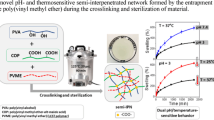Abstract
The controlled release of benzoic acid (3.31 Å) and sulphanilamide (3.47 Å) from poly(vinyl alcohol), PVA, hydrogels fabricated by solution casting at various cross-linking ratios, were investigated. The PVA hydrogels were characterized in terms of the degree of swelling, the molecular weight between cross-links, and the mesh size. The drug release experiment was carried out using a modified Franz diffusion cell, at a pH value of 5.5 and at temperature of 37°C. The amount of drug release and the diffusion coefficients of the drugs from the PVA hydrogels increased with decreasing cross-linking ratio, as a larger mesh size was obtained with lower cross-linking ratios. With the application of an electric field, the amount of drug release and the diffusion coefficient increased monotonically with increasing electric field strength, since the resultant electrostatic force drove the ionic drugs from the PVA matrix. The drug size, matrix pore size, electrode polarity, and applied electric field were shown to be influential controlling factors for the drug release rate.








Similar content being viewed by others
REFERENCES
Rhodes III WE. Iontophoretic drug delivery: new advantages revitalize an established technology. Drug Deliv Technol. 2002;2:34–7.
Kalia YN, Naik A, Garrison J, Guy RH. Iontophoretic drug delivery. Adv Drug Deliv. 2004;56:619–58.
Nho YC, Park SE, Kim HI. Oral delivery of insulin using pH-sensitive hydrogels based on polyvinyl alcohol grafted with acrylic acid/methacrylic acid by radiation. Nucl Instrum Meth Phys Res Sect B. 2005;236:283–8.
Serra L, Domenechc J, Peppas NA. Drug transport mechanisms and release kinetics from molecularly designed poly (acrylic acid-g-ethylene glycol) hydrogels. Biomaterials. 2006;27:5440–51.
Zalfen AM, Nizet D, Jerome C, Jerome R, Frankenne F, Foidart JM, et al. Controlled release of drugs from multi-component biomaterials. Acta Biomater. 2008;4:1778–96.
Langer R, Peppas N. Chemical and physical structure of polymers as carriers for controlled release of bioactive agents: a review. J Macromol Sci Rev Macromol Chem Phys. 1983;23:61–126.
Kim SJ, Park SJ, Lee SM, Lee YM, Kim HC, Kim SI. Electroactive characteristics of interpenetrating polymer network hydrogels composed of poly(vinyl alcohol) and poly(N-isopropylacrylamide). J Appl Polym Sci. 2002;89:890–4.
Li JK, Wang N, Wu XS. Poly (vinyl alcohol) nanoparticles prepared by freezing–thawing process for protein/peptide drug delivery. J Control Release. 1998;56:117–26.
He C, Kim SW, Lee DS. In situ gelling stimuli-sensitive block copolymer hydrogels for drug delivery. J Control Release. 2008;127:189–207.
Peppas NA, Wright SL. Drug diffusion and binding in ionizable interpenetrating networks from poly(vinyl alcohol) and poly(acrylic acid). Eur J Pharm Biopharm. 1998;46:15–29.
Juntanon K, Niamlang S, Rujiravanit R, Sirivat A. Electrically controlled release of sulfosalicylic acid from crosslinked poly(vinyl alcohol) hydrogel. Int J Pharm. 2008;356:1–11.
Paradee N, Sirivat A, Niamlang S, Prissanaroon-Ouajai W. Effects of crosslinking ratio, model drugs, and electric field strength on electrically controlled release for alginate-based hydrogel. J Mater Sci Mater Med. 2012;23:999–1010.
Hickey AS, Peppas NA. Solute diffusion in poly(vinyl alcohol)/(polyacrylic acid) composite membranes prepared by freezing/thawing techniques. Polymer. 1997;38:5931–6.
Peppas NA, Wright SL. Solute Diffusion in poly(vinyl alcohol)/poly(acrylic acid) interpenetrating networks. Macromolecules. 1996;29:8798–804.
Venkatesh S, Hodgin L, Hanson P, Suryanarayanan R. In vitro release kinetics of salicylic acid from hydrogel patch formulations. J Control Release. 1992;18:13–8.
Higuchi WI. Analysis of data on the medicament release from ointment. J Pharm Sci. 1962;51:802–4.
Uslu I, Celikkan H, Atakol O, Aksu ML. Preparation of PVA/chitosan doped with boron composite Fibers and their characterization Hacettepe. J Biol Chem. 2008;36(2):117–22.
Qiu Y, Park K. Environment-sensitive hydrogels for drug delivery. Adv Drug Deliv Rev. 2001;53:321–39.
Pradhan R, Budhathoki U, Thapa P. Formulation of once a day controlled release tablet of indomethancin based on HPMC-Mannitol. KUSET. 2008;1:55–67.
Mahmoodi M, Khosroshahi ME, Atyabi F. Laser thrombolysis and in vitro study of tPA release encapsulated by chitosan coated PLGA nanoparticles for AMI. Int J Biol Biomed Eng. 2010;4:35–42.
Dai WS, Barbari TA. Hydrogel membranes with mesh size asymmetry based on the gradient crosslinking of poly(vinyl alcohol). J Membr Sci. 1999;156:67–79.
Kantaria S, Rees GD, Lawrence MJ. Gelatin stabilized microemultion-based organogels: rheology and application in iontophoretic transdermal drug delivery. J Control Release. 1999;60:355–65.
Massoumi B, Entezmi A. Controlled release of sulfosalicylic acid during electrochemical switching of conducting polymer bilayer. Eur Polym J. 2001;37:1015–20.
Peppas NA, Bures P, Leobandung W, Ichikawa H. Hydrogels in pharmaceutical formulations. J Pharm Biopharm. 2000;50:27–46.
A-sasutjarit R, Sirivat A, Vayumhasuwan P. Viscoelastic properties of carbopol 940 gels and their relationships to piroxicam diffusion coefficients in gel bases. Pharm Res. 2005;22:2134–40.
Niamlang S, Sirivat A. Electrically controlled release of salicylic acid from poly(p-phenylene vinylene)/polyacrylamide hydrogels. Int J Pharm. 2010;356:1–11.
ACKNOWLEDGMENTS
The authors would like to acknowledge the Conductive and Electroactive Polymers Research Unit of Chulalongkorn University, the Center of Petroleum Petrochemical and Advanced Materials, the Thailand Research Fund (BRG), and the Royal Thai Government for their financial supports.
Author information
Authors and Affiliations
Corresponding author
Rights and permissions
About this article
Cite this article
Sittiwong, J., Niamlang, S., Paradee, N. et al. Electric Field-Controlled Benzoic Acid and Sulphanilamide Delivery from Poly(Vinyl Alcohol) Hydrogel. AAPS PharmSciTech 13, 1407–1415 (2012). https://doi.org/10.1208/s12249-012-9869-1
Received:
Accepted:
Published:
Issue Date:
DOI: https://doi.org/10.1208/s12249-012-9869-1




